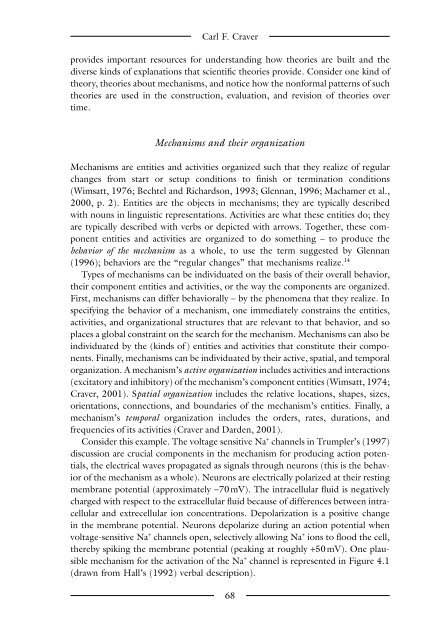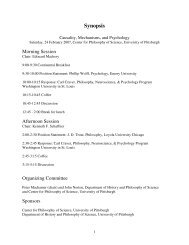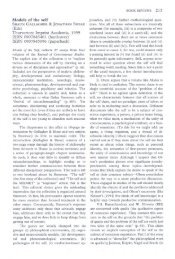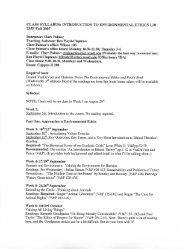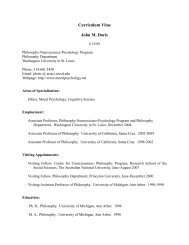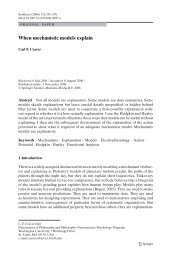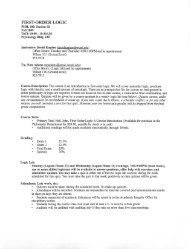The Blackwell Guide to the Philosophy of Science - The Department ...
The Blackwell Guide to the Philosophy of Science - The Department ...
The Blackwell Guide to the Philosophy of Science - The Department ...
You also want an ePaper? Increase the reach of your titles
YUMPU automatically turns print PDFs into web optimized ePapers that Google loves.
Carl F. Craver<br />
provides important resources for understanding how <strong>the</strong>ories are built and <strong>the</strong><br />
diverse kinds <strong>of</strong> explanations that scientific <strong>the</strong>ories provide. Consider one kind <strong>of</strong><br />
<strong>the</strong>ory, <strong>the</strong>ories about mechanisms, and notice how <strong>the</strong> nonformal patterns <strong>of</strong> such<br />
<strong>the</strong>ories are used in <strong>the</strong> construction, evaluation, and revision <strong>of</strong> <strong>the</strong>ories over<br />
time.<br />
Mechanisms and <strong>the</strong>ir organization<br />
Mechanisms are entities and activities organized such that <strong>the</strong>y realize <strong>of</strong> regular<br />
changes from start or setup conditions <strong>to</strong> finish or termination conditions<br />
(Wimsatt, 1976; Bechtel and Richardson, 1993; Glennan, 1996; Machamer et al.,<br />
2000, p. 2). Entities are <strong>the</strong> objects in mechanisms; <strong>the</strong>y are typically described<br />
with nouns in linguistic representations. Activities are what <strong>the</strong>se entities do; <strong>the</strong>y<br />
are typically described with verbs or depicted with arrows. Toge<strong>the</strong>r, <strong>the</strong>se component<br />
entities and activities are organized <strong>to</strong> do something – <strong>to</strong> produce <strong>the</strong><br />
behavior <strong>of</strong> <strong>the</strong> mechanism as a whole, <strong>to</strong> use <strong>the</strong> term suggested by Glennan<br />
(1996); behaviors are <strong>the</strong> “regular changes” that mechanisms realize. 14<br />
Types <strong>of</strong> mechanisms can be individuated on <strong>the</strong> basis <strong>of</strong> <strong>the</strong>ir overall behavior,<br />
<strong>the</strong>ir component entities and activities, or <strong>the</strong> way <strong>the</strong> components are organized.<br />
First, mechanisms can differ behaviorally – by <strong>the</strong> phenomena that <strong>the</strong>y realize. In<br />
specifying <strong>the</strong> behavior <strong>of</strong> a mechanism, one immediately constrains <strong>the</strong> entities,<br />
activities, and organizational structures that are relevant <strong>to</strong> that behavior, and so<br />
places a global constraint on <strong>the</strong> search for <strong>the</strong> mechanism. Mechanisms can also be<br />
individuated by <strong>the</strong> (kinds <strong>of</strong> ) entities and activities that constitute <strong>the</strong>ir components.<br />
Finally, mechanisms can be individuated by <strong>the</strong>ir active, spatial, and temporal<br />
organization. A mechanism’s active organization includes activities and interactions<br />
(excita<strong>to</strong>ry and inhibi<strong>to</strong>ry) <strong>of</strong> <strong>the</strong> mechanism’s component entities (Wimsatt, 1974;<br />
Craver, 2001). Spatial organization includes <strong>the</strong> relative locations, shapes, sizes,<br />
orientations, connections, and boundaries <strong>of</strong> <strong>the</strong> mechanism’s entities. Finally, a<br />
mechanism’s temporal organization includes <strong>the</strong> orders, rates, durations, and<br />
frequencies <strong>of</strong> its activities (Craver and Darden, 2001).<br />
Consider this example. <strong>The</strong> voltage sensitive Na + channels in Trumpler’s (1997)<br />
discussion are crucial components in <strong>the</strong> mechanism for producing action potentials,<br />
<strong>the</strong> electrical waves propagated as signals through neurons (this is <strong>the</strong> behavior<br />
<strong>of</strong> <strong>the</strong> mechanism as a whole). Neurons are electrically polarized at <strong>the</strong>ir resting<br />
membrane potential (approximately -70mV). <strong>The</strong> intracellular fluid is negatively<br />
charged with respect <strong>to</strong> <strong>the</strong> extracellular fluid because <strong>of</strong> differences between intracellular<br />
and extrecellular ion concentrations. Depolarization is a positive change<br />
in <strong>the</strong> membrane potential. Neurons depolarize during an action potential when<br />
voltage-sensitive Na + channels open, selectively allowing Na + ions <strong>to</strong> flood <strong>the</strong> cell,<br />
<strong>the</strong>reby spiking <strong>the</strong> membrane potential (peaking at roughly +50 mV). One plausible<br />
mechanism for <strong>the</strong> activation <strong>of</strong> <strong>the</strong> Na + channel is represented in Figure 4.1<br />
(drawn from Hall’s (1992) verbal description).<br />
68


